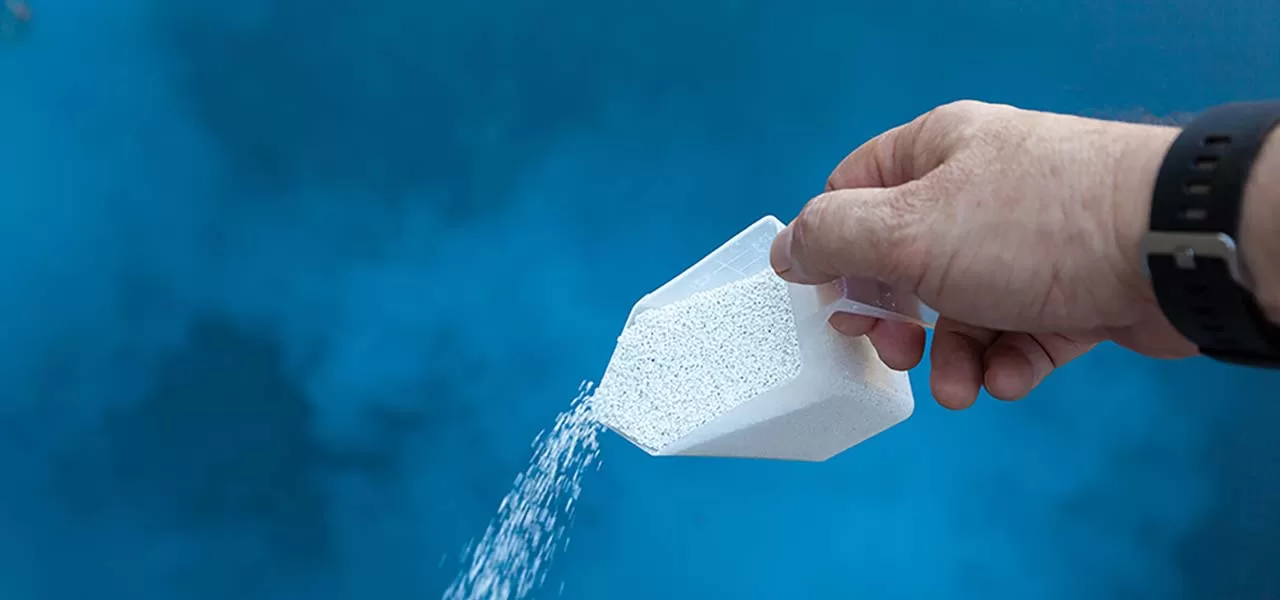FREE Standard Shipping On All Orders $100 or More!*

Pool Shock: When & How Much?
The topic of this post might be shocking to some people…that’s because we’re talking about pool shock! There are lots of questions about why you should shock, when you should shock, and how much shock to use. Today we will discuss the answers to those questions, and give you a better understanding of how pool shock works.
The process of shocking is basically adding a highly concentrated dose of chlorine to the pool water to prevent or resolve problems. Shock will help prevent the growth of algae, bacteria, and chloramines, by raising the level of free available chlorine. It will also help remove those substances if they have taken up residence in your pool.
Why Shock the Pool?

While there are many problems that can be solved by shocking your pool, there are three main ones that we will discuss today. We like to call them the ABCs of Pool Shocking:
- Algae: This pesky organism can wreck havoc on your pool if left to its own devices. Adding shock to your pool regularly will keep algae out of your pool water. Shock is also the main way to rid your pool of algae if it has taken root and spread.
- Bacteria: Similarly to algae, bacteria is definitely not something you want in your pool water. Not only can bacteria damage your pool water, leading to the need to drain your pool, but it can be very harmful to swimmers. Pool shock will prevent and remove bacteria like cryptosporidium, E.coli, and giardia.
- Chloramines: Also known as Combined Available Chlorine (CAC), chloramines are created when Free Available Chlorine (FAC) combine with contaminants such as dirt, rain, bodily fluids, and pollution. While there will always be some chloramines present in swimming pools, an excessive amount is undesirable. Once again, pool shock is the go–to way to ride your pool of too many chloramines.
1. Prevent & Remove Algae
Shock is a great way to rid your pool of algae, in addition to using an algaecide. Pool shock, in the right amounts, will destroy all types of algae by slashing through their slimy outer shells, and disrupting their cellular processes.
Depending on how severe the algae growth is in your pool, you may need to use a large amount of pool shock. Light green or isolated algae may only require 10 ppm (parts per million) of added chlorine to eradicate. Medium green or yellow blooms may need double the dose. For dark green or black algae, adding enough pool shock to reach 30 ppm may be necessary.
Shocking the pool to 30 ppm of free chlorine, with proper pH, eradicates most algae. For best results, vacuum the pool before shocking, and brush the entire pool before and after shocking. Filter nonstop, backwash as needed, and use a pool clarifier after the treatment process to clear up your pool water.
2. Prevent & Remove Bacteria

Stubborn bacteria, viruses and parasites can live in pool water and cause all sorts of problems. Bacteria like cryptosporidium, E. coli, and giardia are more common in public swimming pools where the water is filled with organic material. Proper, routine sanitation and filtration will likely prevent and remove most pathogens, but if you want to be sure, a good pool shock is in order.
The amount of shock needed to remove bacteria depends on the level of bacteria present in the water. Test the pool water for bacteria with a bacteria test kit. It's a good idea to start by adding enough shock to raise your pool water's chlorine level to 30 ppm.
How much chlorine is needed to kill bacteria in swimming pools? It depends on the type of bacteria, and the extent of the contamination. Most types of bacteria found in pools, such as E. coli, are fairly easy to kill with just 2–3 ppm of chlorine. However, the CDC recommends that for pool fecal incidents involving diarrhea, maintain a level of 20 ppm for 13 hours prevent the development of cryptosporidium.
3. Destroy Chloramines
Although it seems counterintuitive, when your pool smells strongly of chlorine, chloramine bonds are likely at a high level, and a good pool shock is needed.
Using a DPD test kit will allow you to measure both FAC and Total Available Chlorine (TAC). Shock the pool to a level 100x greater than your chloramine level. For example, if your chloramine level is at 0.3 ppm, add enough shock to reach a level of 30 ppm. Raising the chlorine level in your pool will break apart the chloramine bonds, and remove them from the water.
Below is a chart detailing how much shock to add for chloramine removal. Remember, this chart assumes a good pH, and a relatively low Cyanuric Acid (CYA) level. More shock is needed for higher levels of stabilizer in the pool, and for pH levels above 7.5.
Amount of Chlorine to Reach Breakpoint Chlorination
(Assumes pH of 7.5, CYA of 30 ppm)
Dosage per 10,000 gallons:
| Chloramine Level | Cal Hypo | Clorox | Dichlor | Lithium Hypo |
| 0.1 | 15 oz | 150 oz | 18 oz | 28 oz |
| 0.3 | 45 oz | 450 oz | 54 oz | 84 oz |
| 0.5 | 75 oz | 750 oz | 90 oz | 130 oz |
Amount of Chlorine to Reach Desired Concentrations
(Assumes pH of 7.5, CYA of 30 ppm, Temperature 75ºF)
Dosage per 10,000 gallons:
| Desired Chlorine Level | Cal Hypo | Clorox | Dichlor | Lithium Hypo |
| 10 ppm | 21 oz | 228 oz | 25 oz | 39 oz |
| 20 ppm | 42 oz | 455 oz | 35 oz | 78 oz |
| 30 ppm | 63 oz | 683 oz | 60 oz | 117 oz |
Like our charts mention, 20 ppm requires a good pH level and a relatively low level of Cyanuric Acid. A tepid temperature of 70-80 degrees is also assumed. High pH, high stabilizer or high temperatures will require a higher concentration of chlorine and/or a longer reaction time to effectively remove bacteria in swimming pools.
How Much Pool Shock Do I Need?

Breakpoint chlorination is a level of chlorine at which point molecular bonds break apart. Conveniently, this is also when the water removes chloramines, algae, and pathogens. For most situations, a level of 30 ppm of chlorine will reach the threshold of breakpoint chlorination needed to restore order in the pool.
Here's a pool shock treatment chart to determine the amount of pool shock necessary to raise the chlorine level above the breakpoint threshold, usually around 30 ppm. This quick reference chart is based on 10,000 gallons of water:
| Pool Shock Type | Increase by 10 ppm |
| Calcium Hypochlorite | 1.3 lbs |
| Sodium Hypochlorite | 3.5 qts |
| Lithium Hypchlorite | 2.5 lbs |
| Dichlor | 1.5 lbs |
For example, using the table above, a 20,000 gallon pool would require 7.8 lbs of cal-hypo to increase the levels by 30 ppm. Check for proper water balance, especially pH in the range of 7.2–7.6, before adding the shock to the pool. A high pH of 7.8–8.2 can render up to half of your pool shock completely inactive.
Proper filtration and circulation are key factors for proper shocking — pool shock doesn't do it all alone. Filter the pool water after treatment to remove any remaining particulates.
How to Shock Your Pool
Shocking your pool is a fairly straightforward process. But it is important to follow the following prep steps before you dive into shocking. Poorly prepared pool water can render the shock ineffective, failing to address the underlying issue.
- Clean Your Pool: Leaves and debris on the floor and surface will waste your chlorine's killing power as it attacks these organic materials, rather than the ABC problem that we are trying to correct.
- Lower the pH: Chlorine is very sluggish at high pH levels. At a pH of 8.0, less than half of the chlorine you add to the water will convert to hypochlorous acid, the killing form of chlorine. Lower the pH to 7.2 before shocking.
- Read the Label: We have many types of pool shock, all with slightly different dosages. For some pool shock, dilution in a bucket is necessary to dissolve the granules and prevent damage to pool surfaces.
- Add the Shock: Distribute the granular chlorine throughout the pool surface with the pool pump running. Be careful not to spill any on your clothing, or on the pool deck, and add the shock slowly and close to the surface of the water. On days with high winds, refrain from shocking your pool to prevent the wind from blowing away the shock from your pool water.
- Brush the Pool: This helps distribute the chemicals, and removes the layer of dust and film on your pool surfaces. A good brushing, vacuuming, and backwashing should follow an algae shock treatment.
Pool shock can also be used in smaller amounts as a quick booster to your chlorine level. This practice is called super chlorination. Usually just a pound of shock will bring chlorine levels up from zero to a range that will prevent problems. Waiting for tablets to dissolve could take too long, so if you find your chlorine level at zero, use a pound or two of pool shock to bring up the chlorine level quickly.
The moral of the story is that you have to test your pool to know when to shock. Shocking monthly or even weekly is overkill in many cases.